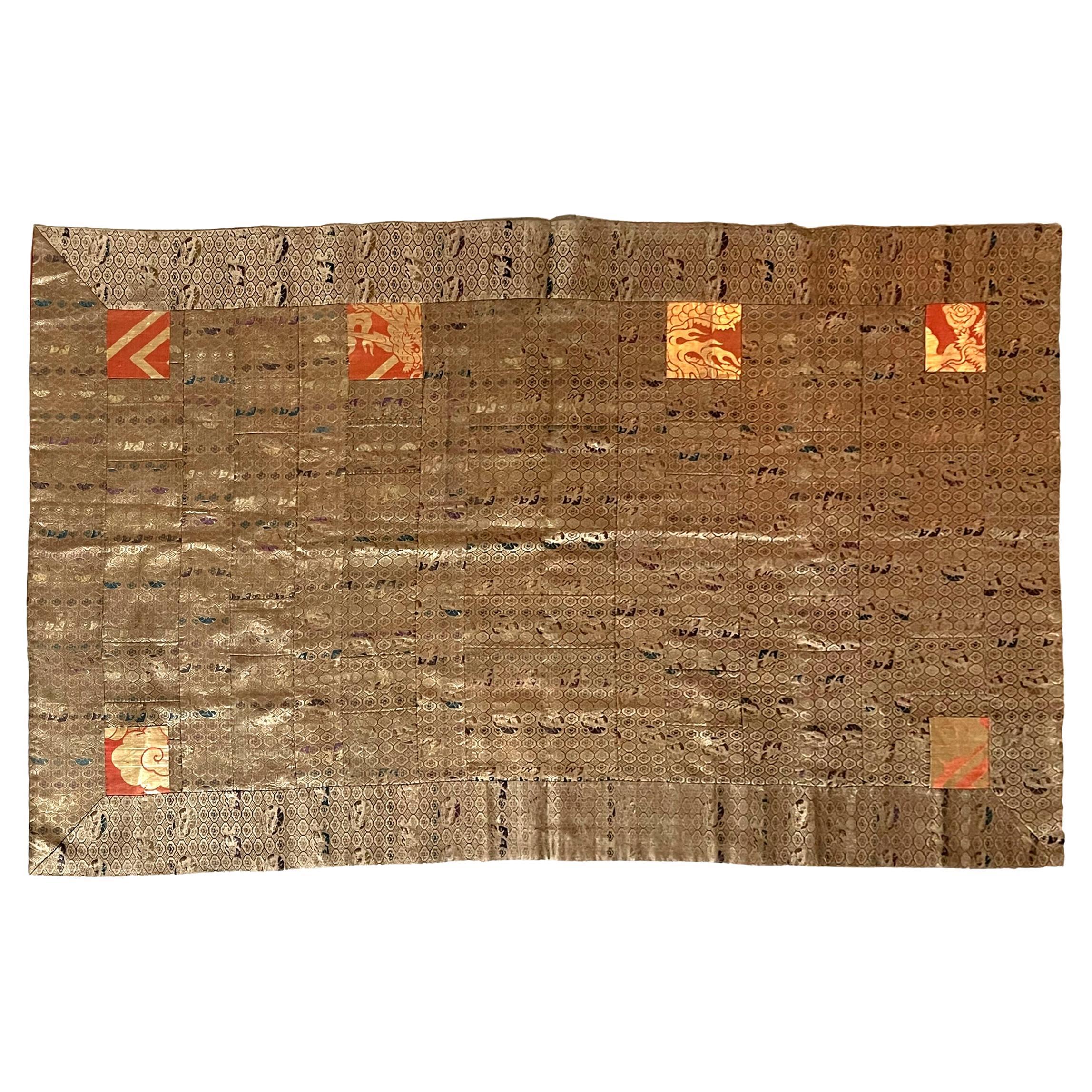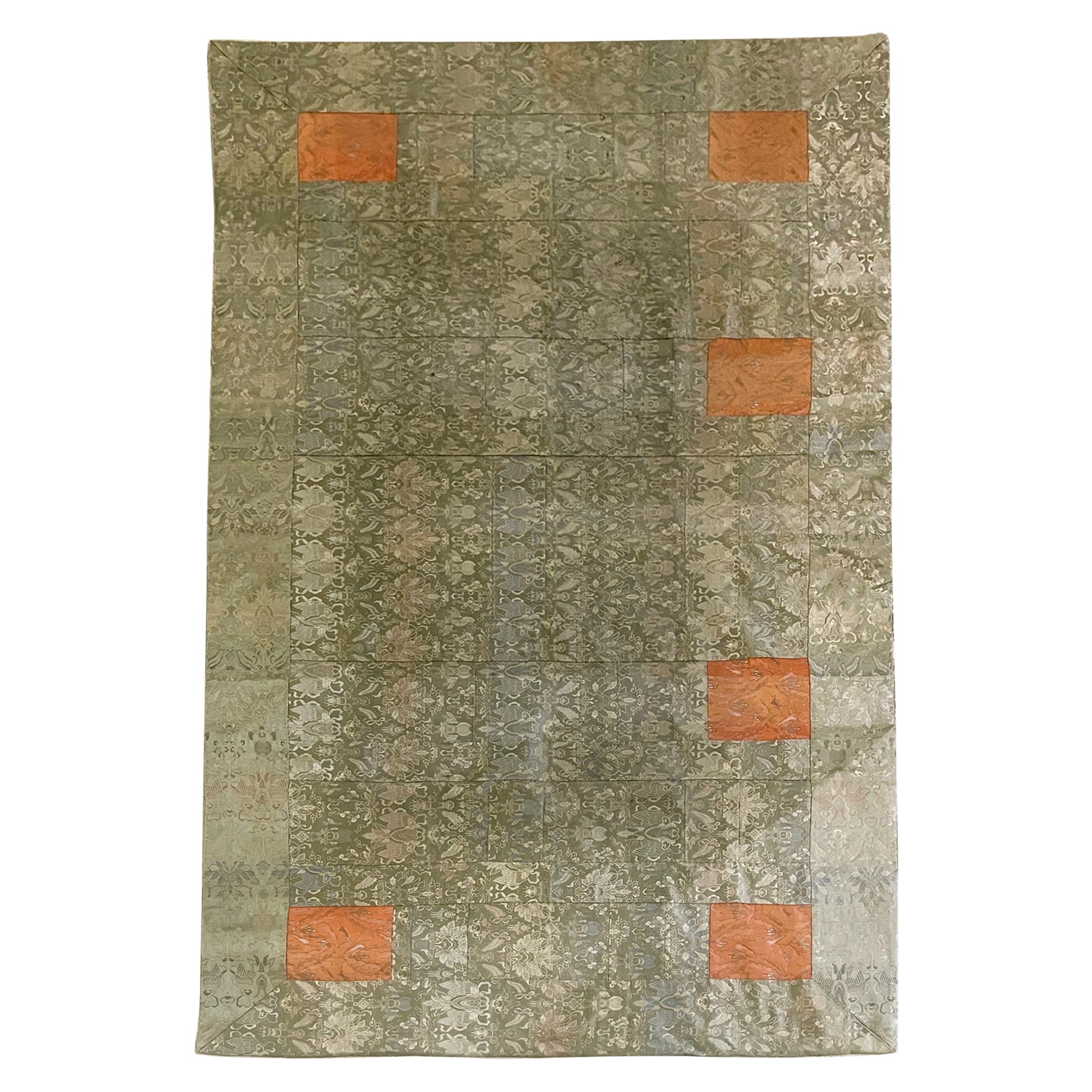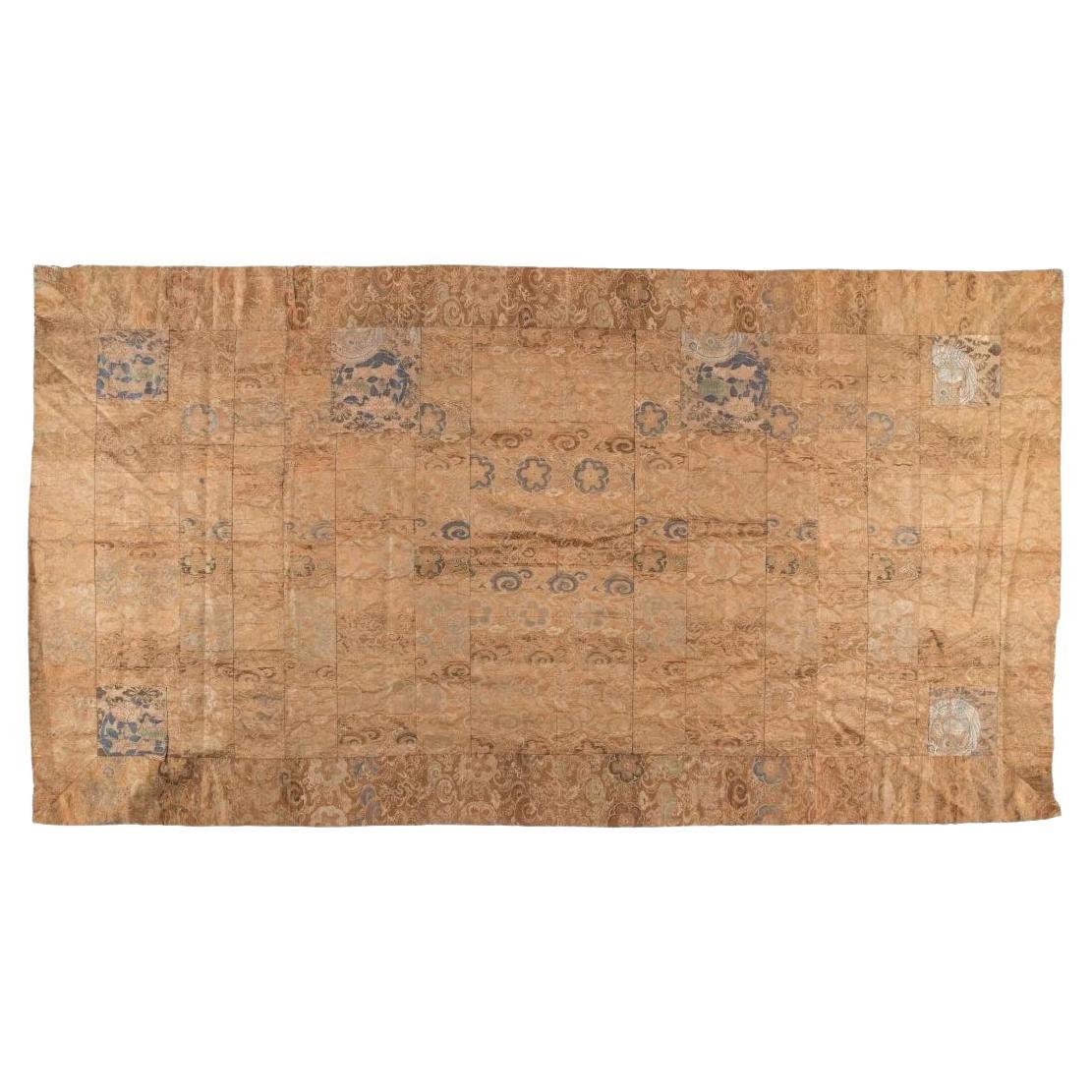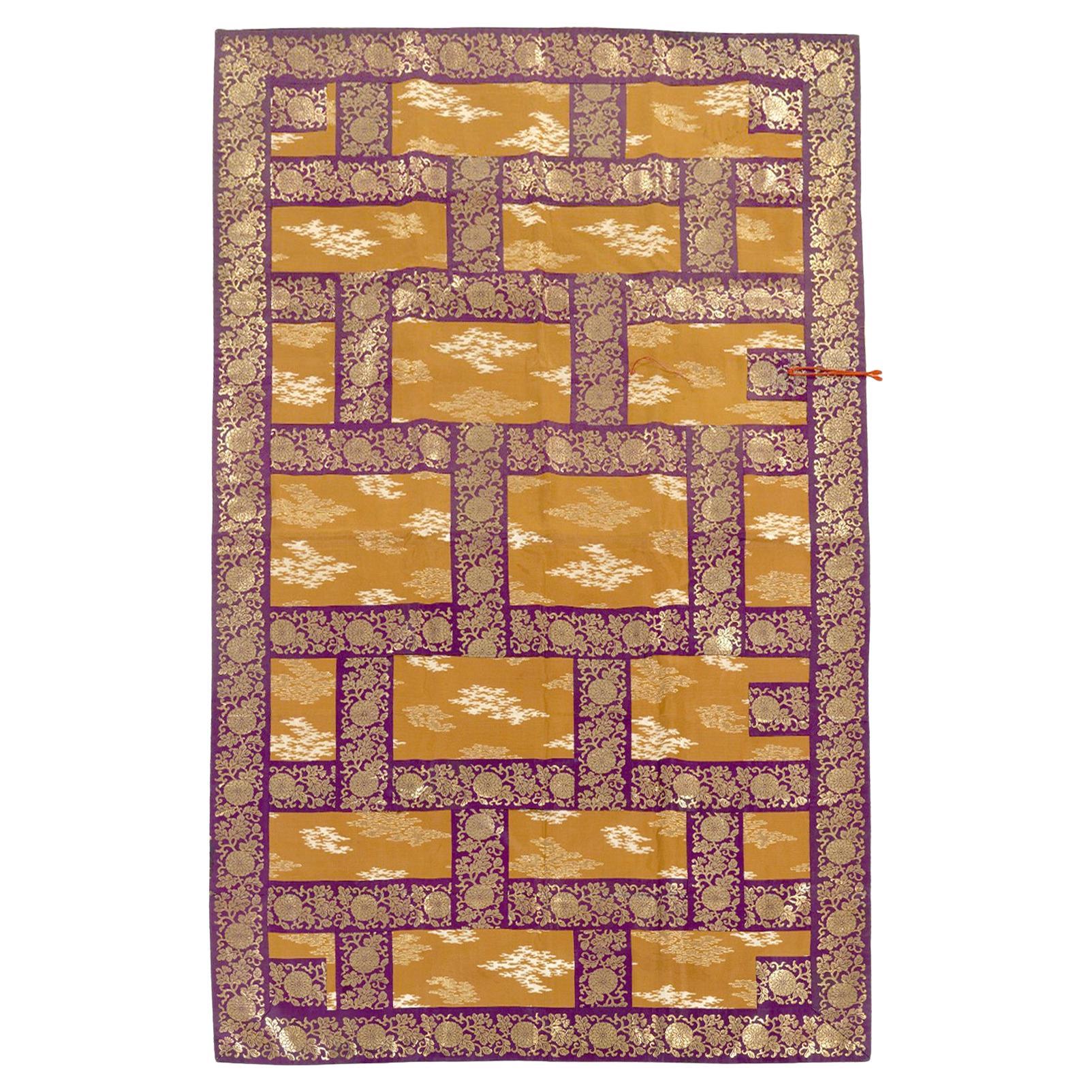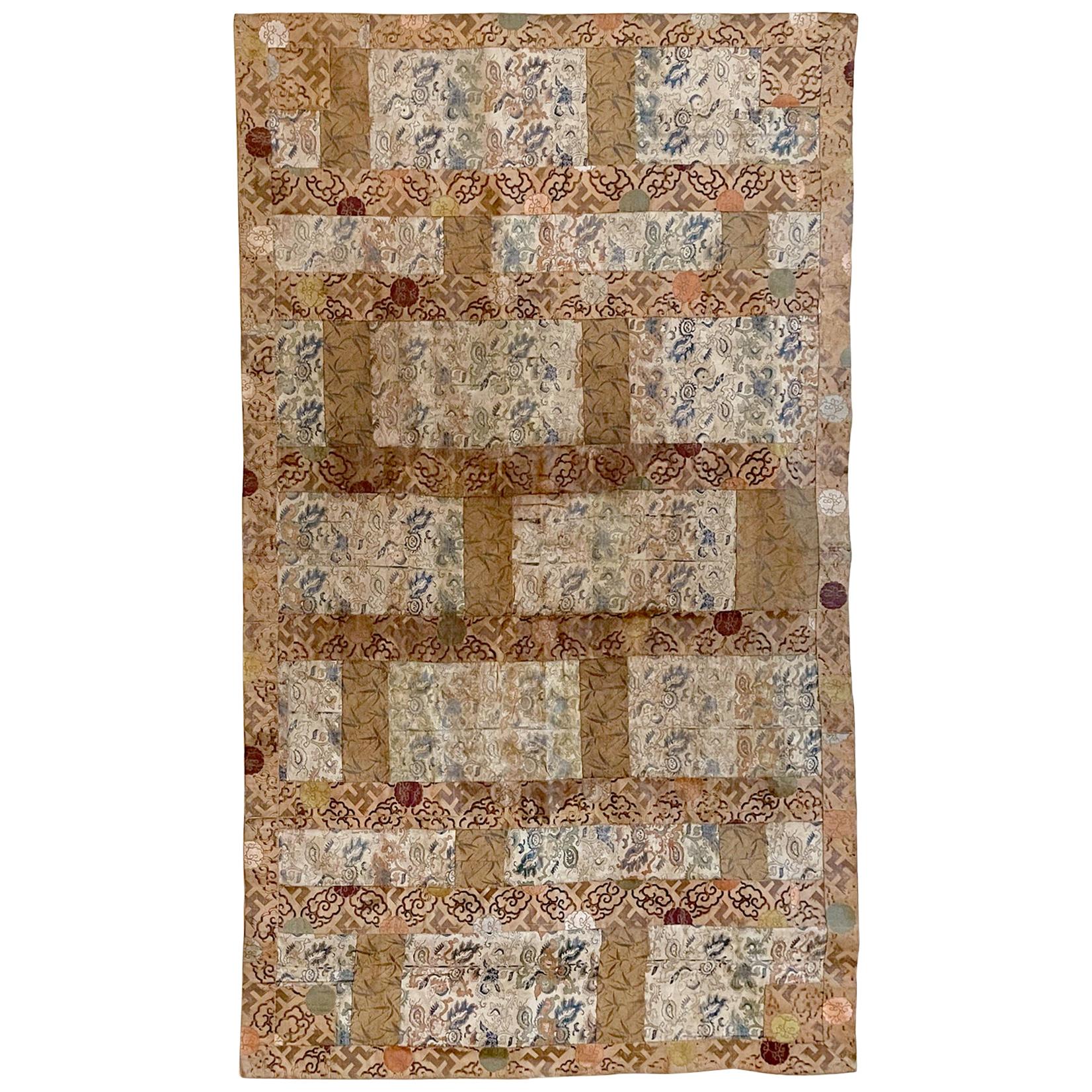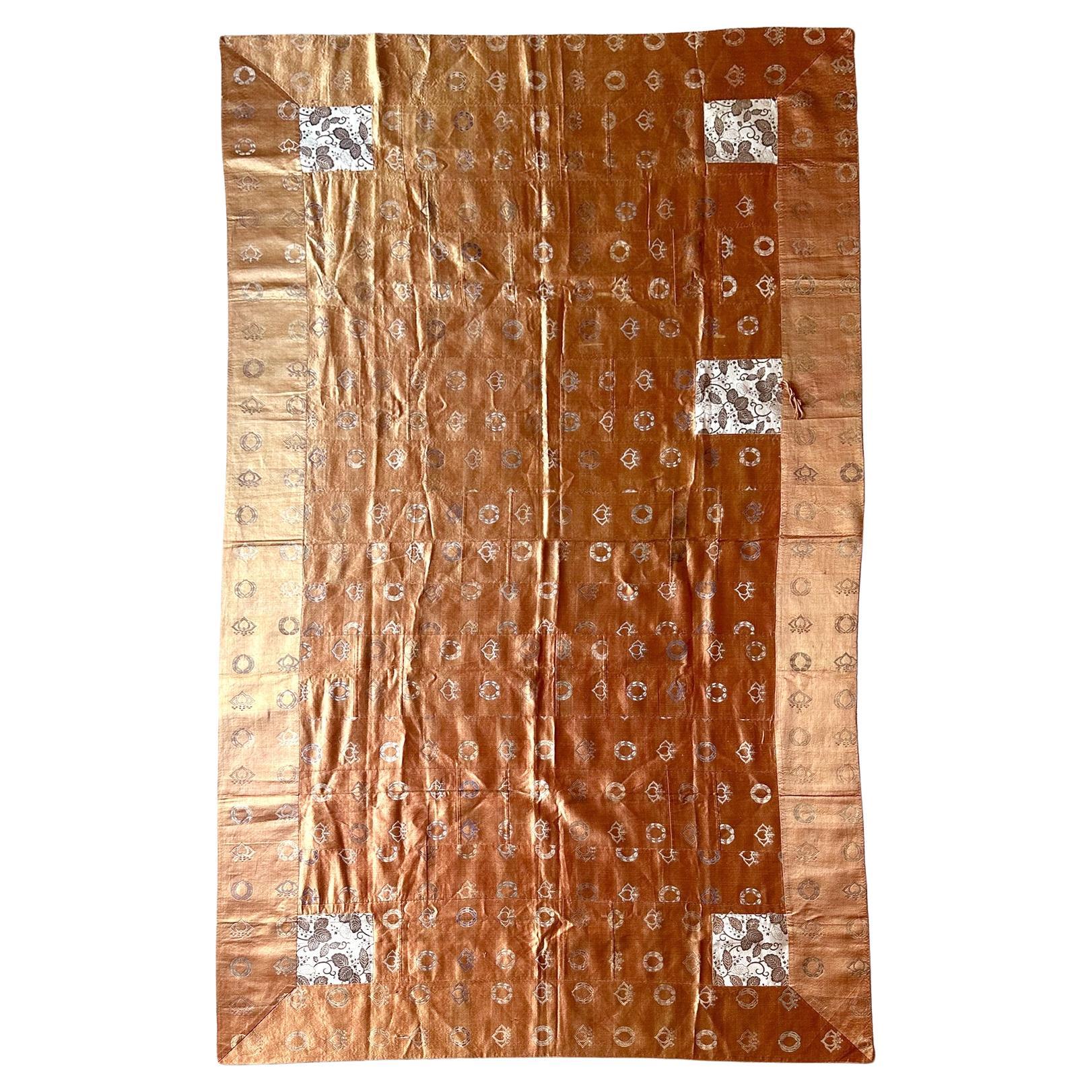Items Similar to Magnificent Antique Japanese Woven Brocade Kesa Monk's Robe Meiji Period
Want more images or videos?
Request additional images or videos from the seller
1 of 21
Magnificent Antique Japanese Woven Brocade Kesa Monk's Robe Meiji Period
About the Item
A stunning Japanese Kesa (Monk's Vestment) made from thirteen columns of patchworks of shimmering woven brocades with luxuriant golden threads. Dated to late 19th century of Meiji Period, the elaborate woven motifs on this kesa feature repetitive roundels dragon and phoenix intermixed with peonies and chrysanthemum blossoms. Two shades of contrasting gold threads were used on a striking purplish-blue background, with a dark metallic thread for the outer border and a brighter thread for the main body. The brilliantly woven fabric was possibly recycled from Noh costumes, one common tradition in the Meiji period. Six silk squares in contrasting orange color, each woven with a golden phoenix in the center surrounded by a silvery slithering dragon, were sewn to the four corners and the upper longitude side of the Kesa. This completes the symbolism of the robe: the four squares in the corners represent the Four Heavenly Kings (Shi Tenno); while the two slightly larger squares in the middle section represent two compassionate bodhisattvas. Two orange robe ties remain attached to the front. The back of the Kesa was lined with a blue damask silk with a subtle woven pattern. Two loops remained with hand-stitches. The top has a later added stripe of loops that allows the piece to be hung on a pole for display.
The kesa is in remarkably fine condition, other than folding marks and some discoloration on the back. It makes a bespoken textile art.
Kesa is derived from the Sanskrit word kasaya, meaning “dark colored,” a reference to the saffron colored robes worn by early Indian Buddhist monks. It is essentially a rectangular cloth originally sewn from patches of rags, being formless, it serves as a symbolism of the ascetic life of one's choosing. In Japan, since at least the Heian period (794–1185), the kesa has been worn by Buddhist priests as their outermost robe, draped over the left shoulder and attached under the right armpit. While it served some function of protection, it was more a signal of the wearer’s faith, and became increasingly elaborate over the centuries. During the Edo period (1600–1868), many kesa worn were patched together from exquisite silk brocade fabrics that were donated to the temples by members of the aristocracy, ruling military class, or wealthy merchants. By stitching the fabric into a patchwork robe, the monks concentrated their attention on the creation of a devotional work of art, every stitch part of an act of meditation on the teachings of the Buddha. The number of stripes (from 5 to up to 25) indicates the wearer’s rank and the occasion for which it was worn, the highest number of stripes usually only being worn by an abbot during festival ceremonies. The normal daily kesa generally have seven columns. The kesa on offer is more likely a ceremonial robe for special occasion.
- Dimensions:Height: 45 in (114.3 cm)Width: 78 in (198.12 cm)Depth: 0.1 in (2.54 mm)
- Style:Meiji (Of the Period)
- Materials and Techniques:
- Place of Origin:
- Period:
- Date of Manufacture:1880-1900
- Condition:Wear consistent with age and use. Fine antique textile condition. One of the best Kesa we've had, quality and condition wise. Expected only minor wear in keeping with age. Backing with minor fading. Hanging loop on the back was added later.
- Seller Location:Atlanta, GA
- Reference Number:1stDibs: LU945039169122
About the Seller
5.0
Platinum Seller
These expertly vetted sellers are 1stDibs' most experienced sellers and are rated highest by our customers.
Established in 2006
1stDibs seller since 2010
479 sales on 1stDibs
Typical response time: <1 hour
- ShippingRetrieving quote...Ships From: Atlanta, GA
- Return PolicyA return for this item may be initiated within 2 days of delivery.
More From This SellerView All
- Antique Japanese Brocade Kesa Monk's Robe Meiji PeriodLocated in Atlanta, GAA stunning Japanese Kesa (Monk's Vestment) made from thirteen columns of patchworks of shimmering woven brocades. The elaborate motifs feature repetitive...Category
Antique Late 19th Century Japanese Meiji Textiles
MaterialsBrocade, Silk
- Antique Japanese Brocade Monk's Robe Kesa Meiji PeriodLocated in Atlanta, GAA Japanese Kesa (Monk's Vestment) made from thirteen columns of patchworks of shimmering woven brocades. The elaborate motifs feature repetitive elaborat...Category
Antique Late 19th Century Japanese Meiji Textiles
MaterialsBrocade, Silk
- Antique Japanese Brocade Kesa Monk's Robe Edo PeriodLocated in Atlanta, GAA Japanese Kesa (Monk's Vestment) made from thirteen columns of patchworks of shimmering woven brocades. The elaborate motifs feature repetitive hibiscus flowers within framework of ...Category
Antique 19th Century Japanese Edo Textiles
MaterialsBrocade, Silk
- Antique Silk Kesa Monk's Patched Robe Meiji PeriodLocated in Atlanta, GAKesa, known as "Jiasha" in Chinese and "Kasaya" in Sanskrit, is an out-layer garment worn by the ordained Buddhist monks. Bearing a basic rectangular form, it developed originally in...Category
Antique 19th Century Japanese Meiji Textiles
MaterialsTextile, Brocade
- Antique Brocade Kesa Monk's Patched Robe Edo PeriodLocated in Atlanta, GAKesa, known as "Jiasha" in Chinese and "Kasaya" in Sanskrit, is an out layer garment worn by the ordained Buddhist monks. Bearing a basic rectangular form, it developed originally in...Category
Antique Late 18th Century Japanese Edo Textiles
MaterialsTextile, Brocade
- Antique Japanese Embroidered Silk Kesa Monk's Robe Edo PeriodLocated in Atlanta, GAA Japanese Kesa (Monk's Vestment) made from thirteen columns of patchworks of fine shimmering silk fabric of a salmon orange color, the shade of which changed subtly from different a...Category
Antique 19th Century Japanese Edo Textiles
MaterialsBrocade, Silk
You May Also Like
- Japanese Buddhist Monk Priest 7 Column Silk Brocade Kesa Ceremonial Temple RobeLocated in Studio City, CAA wonderful, beautifully ornamented and somewhat rare fully intact Japanese Buddhist monk/ priest's Kesa ceremonial silk robe featuring various colorful birds in flight. Kesa (which came from the Chinese word "kasaya") robes have been handmade/handstitched by monks/priests as an act of devotion as ceremonial robes for centuries in various Asian cultures (Japanese, Chinese, Korean, Vietnamese, Indian, etc.). The kesa is a rectangular garment designed to be worn over the left shoulder (see example image). The robes are made (often in a patchwork column pattern ranging from five, seven, nine or more pannels) specifically for fully ordained Buddhist monks, priests and nuns and are made from donations of exquisite textiles from wealthy patrons of Japanese Buddhist temples. The robes were used in daily ceremonies, temple gatherings, and private meditation. Antique Kesa robes...Category
Mid-20th Century Japanese Showa Textiles
MaterialsTextile, Brocade, Silk
- Japanese Edo Buddhist Monk Priest 7 Column Silk Brocade Kesa Ceremonial RobeLocated in Studio City, CAA wonderful, brightly coloured and somewhat rare fully intact Japanese Buddhist monk/ priest's Kesa ceremonial silk robe. Kesa (which came from the Chinese word "kasaya") robes have been handmade/handstitched by monks/priests as an act of devotion as ceremonial robes for centuries in various Asian cultures (Japanese, Chinese, Korean, Vietnamese, Indian, etc). The kesa is a rectangular garment designed to be worn over the left shoulder (see example image). The robes are made (often in a patchwork column pattern ranging from five, seven, nine or more pannels) specifically for fully ordained Buddhist monks, priests and nuns and are made from donations of exquisite textiles from wealthy patrons of Japanese Buddhist temples. The robes were used in daily ceremonies, temple gatherings, and private meditation. Antique Kesa robes...Category
Antique 19th Century Japanese Edo Textiles
MaterialsTextile, Brocade, Silk
- Meiji Period Japanese Indigo Double Ikat Futon CoverLocated in Point Richmond, CAMeiji period Japanese Indigo double ikat futon cover Japanese futon cover, a double ikat pattern in four panels depicting Kumamoto Castle with im...Category
Antique 1890s Japanese Meiji Textiles
MaterialsCotton
- Late Meiji Period Sleeping Kimono / Yogi, JapanLocated in Point Richmond, CALate Meiji Period sleeping Kimono / Yogi, Japan Yogi are a type of oversized sleeping kimono traditionally used in Japan. This kimono would have b...Category
Early 20th Century Japanese Tribal Textiles
MaterialsCotton
- Vintage Orange Silk Japanese Obi with Gold and Silver Lamé and BrocadeLocated in Topeka, KSHandsome vintage Japanese obi in orange silk with gold and silver lamé and brocade flower and leaf design. It is in wonderful vintage condition. We have detected a small dark spot on...Category
Mid-20th Century Japanese Japonisme Tapestries
MaterialsSilk
- Antique Early 20th Century Japanese Hand Stitched Silk Framed TapestryLocated in Lambertville, NJAll hand work framed silk Japanese tapestry with embroidered boarder. A deep custom black lacquered frame. Originaly sold from Newman Galleries....Category
Early 20th Century Japanese Meiji Textiles
MaterialsSilk, Glass, Lacquer
Recently Viewed
View AllMore Ways To Browse
Tucuman Tapestry
Marble Top Circular Center Table
Claw Ball Feet Chair
Dining Room Set Table 8 Chairs
Chest Military Chest
Low Iron Glass
Peach Contemporary Rugs
Deco Spring Chair
Dark Stained Side Table
Two Panel Room Divider
Bistro Table Top
19th Century Persian Textiles
Country Wood Benches
Antique Cabinet With Sliding Doors
Corner Knobs
Hanging Plate Set
Italian Console Table Long
Sculptural Wood Pendant
